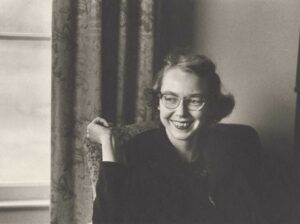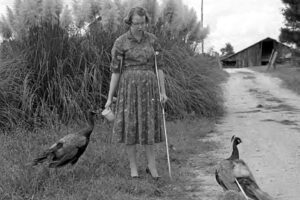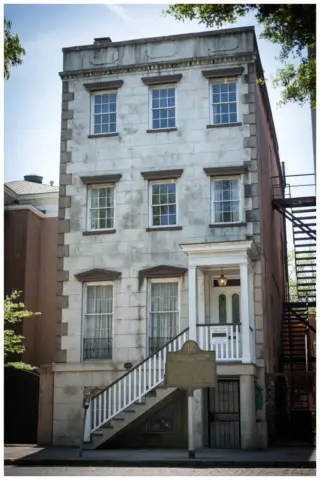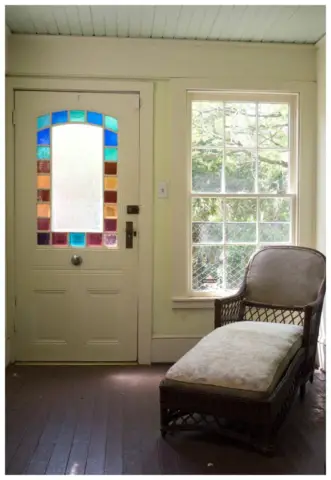About Flannery O’Connnor:
Born in Savannah on March 25, 1925, Mary Flannery O’Connor was an only child. She attended St. Vincent’s Catholic school in Savannah until 1938, when the family was forced to move to Milledgeville due to her father’s illness (an illness, unbeknownst to them, he would pass on to his daughter). There they lived in her mother’s ancestral home, an antebellum brick house which had been constructed in the 1820s.
She attended St. Vincent’s Academy until 5th grade and Sacred Heart Academy until 7th grade when the family moved to Atlanta for her father’s work and then to Milledgeville shortly after when her father became ill. Her father died in 1941 from the effects of lupus erythematosus, an incurable disease of metabolic origin.
Since Milledgeville contained only a small Catholic population, one Catholic church and no parochial schools, Flannery attended Peabody High School in nearby Milledgeville , from which she graduated in 1942. She then enrolled in the Georgia State College for Women, later known as Georgia College, from which she graduated with a B.A. in social science in 1945. While there she served as editor of the literary quarterly, The Corinthian, and as art editor for The Colonnade, the student newspaper.
 Following graduation, she received a scholarship from and enrolled in the Writers Workshop at the State University of Iowa, receiving a Master of Fine Arts degree from that institution in 1947.
Following graduation, she received a scholarship from and enrolled in the Writers Workshop at the State University of Iowa, receiving a Master of Fine Arts degree from that institution in 1947.
On the strength of having her first story, “The Geranium,” published in Accent magazine in 1946 and having won the Rinehart-Iowa Fiction Award in 1947, O’Connor was recommended for a place at Yaddo, a writers colony located in Saratoga Springs, New York. She remained there only a few months, however, leaving along with all the other writers in residence because of an FBI investigation into the long-term stay of a well-known journalist alleged to be a Communist party member and the negative publicity which was generated because of that investigation.
She would go on to write two novels and 31 short stories, as well as a number of reviews and commentaries.
In December 0f 1950 she became ill and was admitted to a hospital in Atlanta. Her illness was diagnosed as lupus, and the doctors offered her mother little hope that Flannery would recover. Blood transfusions and massive doses of ACTH, at that time an experimental drug, produced a remission of the disease. Following her release from the hospital in 1959, she moved to Andalusia, the dairy farm which her mother had inherited from a brother and which was located near Milledgeville.
She spent most of her life in and arounde Milledgeville. Her mobility was greatly reduced by the ravages of her disease and/or by the high doses of ACTH which she took to hold the disease in check until finally she was forced to move about on crutches. Despite her disability, she did make occasional lecture trips to colleges and universities as well as occasional trip to visit friends. In May 1958 Flannery O’Connor and her mother were given a pilgrimage to Lourdes. From there they went to Rome and were granted an audience with Pope Pius XII. She also traveled to Notre Dame in 1962, and to Smith College in 1963, to receive honorary Doctor of Letters degrees. O’Connor spent most of the remainder of her life in and around Milledgeville.
 Watched over by her mother, O’Connor usually spent the morning hours at her writing while her afternoons were occupied by painting, reading, tending her flocks of peacocks, geese, and chickens, and carrying on correspondence with friends and increasingly large numbers of individuals who wrote her concerning her stories. She kept peacocks on her property. Ever wonder why people keep peacocks? We did….and here’s the answer: they make good watchdogs (pardon the expression) and eat vermin and snakes.
Watched over by her mother, O’Connor usually spent the morning hours at her writing while her afternoons were occupied by painting, reading, tending her flocks of peacocks, geese, and chickens, and carrying on correspondence with friends and increasingly large numbers of individuals who wrote her concerning her stories. She kept peacocks on her property. Ever wonder why people keep peacocks? We did….and here’s the answer: they make good watchdogs (pardon the expression) and eat vermin and snakes.
In February 1964, O’Connor underwent surgery for a benign tumor; unfortunately, this surgery reactivated the lupus and she died on August 3, 1964.
A sad note to her legacy is the removal of her name from a building at Loyola University Maryland. In the age of the “cancel culture” her name was removed due to a petition from some students alleging her racism. Such is the ignorance of such a move is that most of the signers of the petition were not even aware of who Flannery O’Connor was. You can read more about this here in an article in Commonweal Magazine.
As people continue to tear down the memory of what made our Western Civilization so great, we wonder what will fill that vaccuum.
About the Flannery O’Connnor Childhood Home Museum:
The Flannery O’Connor Childhood Home Museum works to continue the legacy of Flannery O’Connor by providing educational opportunities through guided tours, informative lectures, and literary events. Each room of the museum has been closely restored to the Depression era, presenting unique insights into this time period in Savannah and into the formative years of one of America’s greatest writers.
While visiting them, please consider shopping from their selection of fiction and nonfiction books by O’Connor as well as their stationery, mugs, stickers, and other special Flannery-related items.
Photo credits Flannery O’Connor Childhood Home Museum
Address: 207 E. Charleton Street, Savannah, Georgia 31401
Tel: 912-233-6014
Click here for the official website of the Flannery o’Connor Childhood Home Museum




